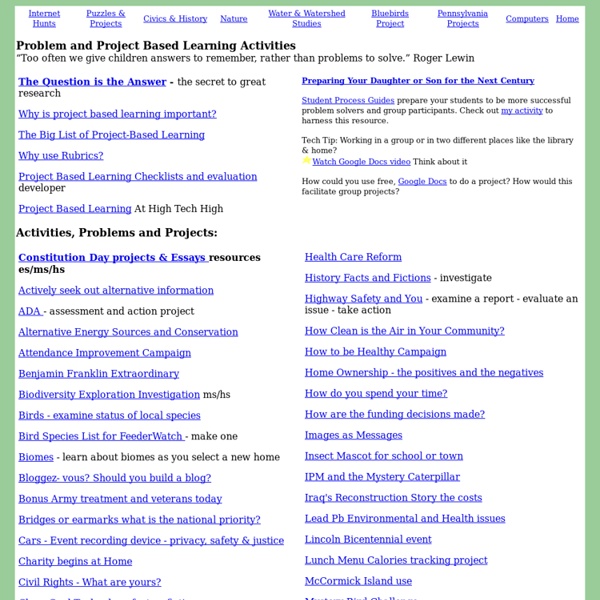



http://www.mrsoshouse.com/pbl/pblin.html
PBL.TO: Summary for POLLARD BANKNOTE LIMITED- Yahoo! Finance Pollard Banknote Limited (PBL.TO) -Toronto Quotes delayed, except where indicated otherwise. Currency in CAD. Headlines About PBL Want to build a portfolio of documented accomplishments before you enter the job market? PBL (the collegiate division of FBLA) activities can complement your academic experience and give you an edge in your future career. During a job interview, you can point to the leadership positions you held for the largest collegiate business student organization in the world. Problem-Based Learning (PBL) Summary: Problem-Based Learning (PBL) is an instructional method of hands-on, active learning centered on the investigation and resolution of messy, real-world problems. Originators: Late 1960s at the medical school at McMaster University in Canada. Key Terms: open-ended problems, self-directed learners, teacher as facilitator, student as problem solver Problem-Based Learning (PBL) Problem-Based Learning (PBL) is a pedagogical approach and curriculum design methodology often used in higher education and K-12 settings.
Problem-Based Learning and Project-Based Learning While Project-Based Learning and Problem-Based Learning share much in common, they are two distinct approaches to learning. In Project-Based Learning, students have a great deal of control of the project they will work on and what they will do in the project. The project may or may not address a specific problem. In Problem-Based Learning, a specific problem is specified by the course instructor.
definition of PBL by Medical dictionary Due to these budgetary pressures and statutory requirements, many PBL contracts require that a portion of maintenance work be done in government depots. In a nutshell, when properly implemented, PBL works. PBL is a pedagogical approach that supports student learning through the experience of solving realistic problems, such as answers to "Where would you place a 22nd mission" or "Do beavers belong in the Guadalupe River? Furthermore, for both teachers and students in PBL environments, learning how to effectively manage and lead projects can be the key to more deeply engaged and self-motivated learners, as well as more productive learning collaborations and teamwork. The Apache PBL team was honored with the 2011 and 2013 Secretary of Defense PBL Awards recognizing outstanding achievements in providing soldiers with exceptional operational support. The Sniper ATP PBL team manages a variety of sustainment efforts, including maintenance, repairs and obsolescence.
Premier Basketball League The Premier Basketball League, often abbreviated to the PBL, is an American professional men's basketball minor league that began play in January 2008. In the past, there have been teams also in Canada and Puerto Rico. The league season typically operates from January to April. History Problem-Based Learning What is problem-based learning? Why use problem-based learning? What are the basic steps in designing a problem-based learning project? What is problem-based learning? Problem-Based Learning at University of Delaware In a problem-based learning (PBL) class, students work together in small groups to solve real-world problems. PBL is an active and iterative process that engages students to identify what they know and, more importantly, what they don't know. Their motivation to solve a problem becomes their motivation to find and apply knowledge.
What is PBL? To help teachers do PBL well, we created a comprehensive, research-based model for PBL — a "gold standard" to help teachers, schools, and organizations to measure, calibrate, and improve their practice. In Gold Standard PBL, projects are focused on student learning goals and include Essential Project Design Elements: PBL - What does PBL stand for? The Free Dictionary A lot of effort and resources have been placed into educating defense officials on the benefits of PBL, debunking myths and hyperbole that have surrounded these contracts and expanding training programs to grow the skill set for crafting complex performance-based arrangements, he said. The DoD defines PBL as being "synonymous with performance-based life cycle product support, where outcomes are acquired through performance-based arrangements that deliver warfighter requirements and incentivize product support providers to reduce costs through innovation. All students, regardless of their socioeconomic or cultural backgrounds, deserve the opportunity to discover their own voice through PBL and the authentic learning that can come from exploring the true depths of a question. While most educators wholeheartedly advocate for PBL, in practice, many arc apprehensive because PBL requires the ability to design and facilitate effective classroom learning projects.
PROBLEM BASED LEARNING DESCRIPTION As an MBA, you will have to be an accomplished problem-solver of organizational design and change situations. You will also have to be a self-directed learner your entire professional life, as knowledge in the field of management will change, and you will continuously be meeting new and unexpected challenges. The consideration of these factors such as these dictates the wisdom of a problem-based, student-centered, self-directed program that will allow you, the student, in collaboration with your group and instructor, to design an experience tailor-made to your individual needs. What Is Problem-Based Learning (PBL)? Problem-based learning (PBL) is an approach that challenges students to learn through engagement in a real problem. Problem-based learning is student-centered.
Problem-based learning Problem-based learning (PBL) is a student-centered pedagogy in which students learn about a subject through the experience of solving an open-ended problem found in trigger material. The PBL process does not focus on problem solving with a defined solution, but it allows for the development of other desirable skills and attributes. This includes knowledge acquisition, enhanced group collaboration and communication.
Project Based Learning Search for a PBL Plan PBL Tools What is standards-focused Project Based Learning (PBL)?